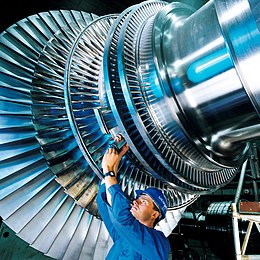
Back عنفة بخارية Arabic Парна турбина Bulgarian বাষ্পীয় টার্বাইন Bengali/Bangla Turbina de vapor Catalan Ӏаьнаран турбина CE تۆرباینی ھەڵمی CKB Parní turbína Czech Dampturbine Danish Dampfturbine German Ατμοστρόβιλος Greek

A steam turbine is a machine that extracts thermal energy from pressurized steam and uses it to do mechanical work on a rotating output shaft. Its modern manifestation was invented by Charles Parsons in 1884.[1][2] Fabrication of a modern steam turbine involves advanced metalwork to form high-grade steel alloys into precision parts using technologies that first became available in the 20th century; continued advances in durability and efficiency of steam turbines remains central to the energy economics of the 21st century.
The steam turbine is a form of heat engine that derives much of its improvement in thermodynamic efficiency from the use of multiple stages in the expansion of the steam, which results in a closer approach to the ideal reversible expansion process.
Because the turbine generates rotary motion, it can be coupled to a generator to harness its motion into electricity. Such turbogenerators are the core of thermal power stations which can be fueled by fossil fuels, nuclear fuels, geothermal, or solar energy. About 42% of all electricity generation in the United States in the year 2022 was by use of steam turbines.[3]
Technical challenges include rotor imbalance, vibration, bearing wear, and uneven expansion (various forms of thermal shock). In large installations, even the sturdiest turbine will shake itself apart if operated out of trim.
- ^ Stodola 1927.
- ^ "Sir Charles Algernon Parsons". Encyclopædia Britannica. n.d. Retrieved 19 September 2010.
- ^ "Electricity Net Generation From An Electric Turbine". US EIA. March 2024.
© MMXXIII Rich X Search. We shall prevail. All rights reserved. Rich X Search